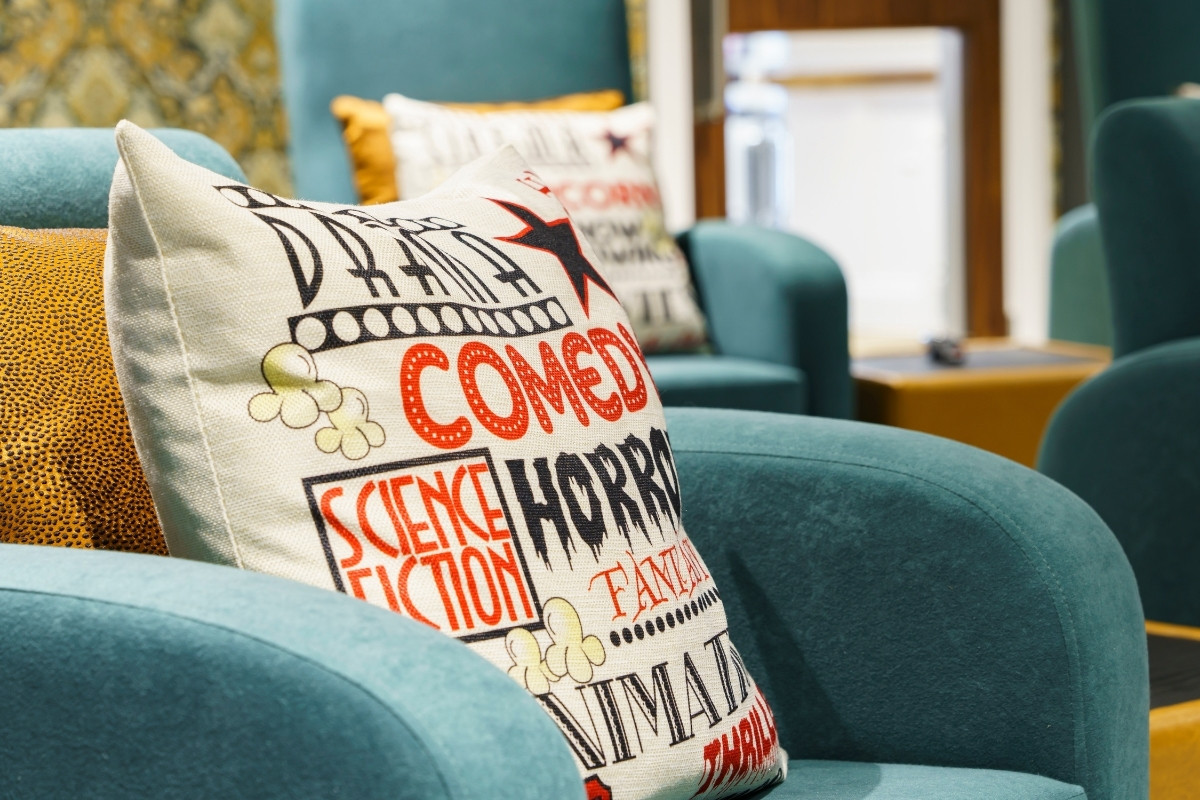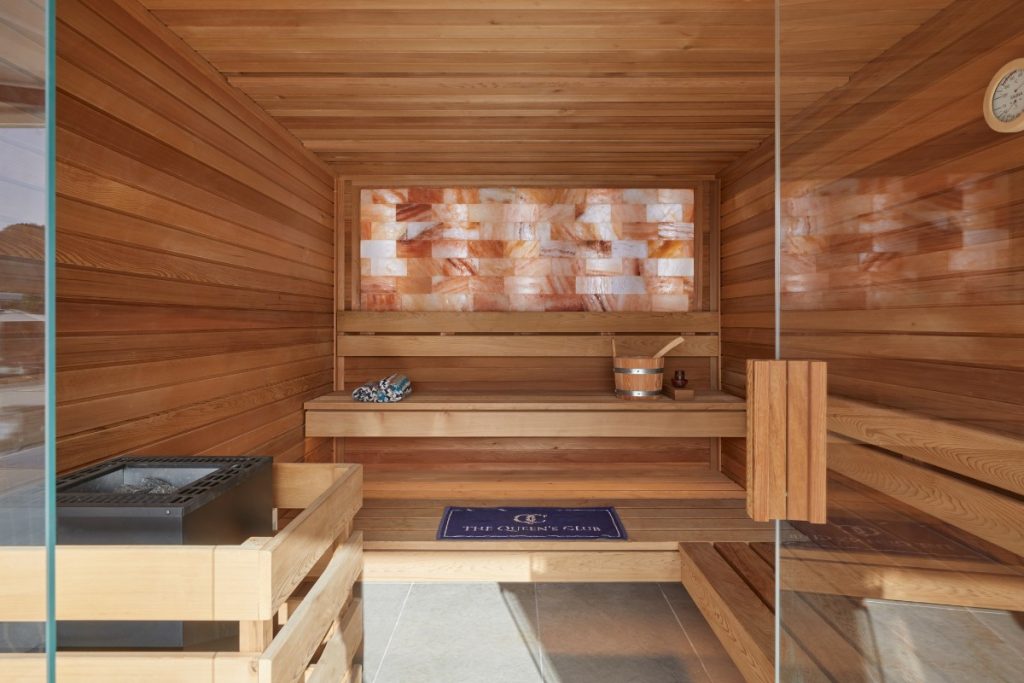 17th June 2022 | IN HEALTHCARE & WELLNESS | BY SBID
17th June 2022 | IN HEALTHCARE & WELLNESS | BY SBIDWith rising costs, is a “five-star” luxury space what residents want and need?
One of Just Imagine Interiors‘ favourite parts of designing a care home is the ability to design an exciting new cinema room for residents. As you will see not only is this a vibrant and fun space to be but its benefits are endless when it comes to bringing people together. This is where our design and creativity really flows, in order to achieve a fun space for residents to relax and enjoy the movie.
Why are cinema rooms so important in care homes, specifically dementia care homes? Who doesn’t love a feel-good movie? Being able to switch off from the outside world with a good movie, in a comfortable chair or preferably a recliner, cosy blanket and a bag of popcorn can revert a bad day into a good day. For residents living with dementia – something as simple as watching a comedy movie or a nostalgic film of the past can help ease stress and anxiety by being so immersed in the film it can be a form of escapism.

We start with the design and choice of funky furniture. We like to be more daring with our colour choices, using vibrancy to add to the fun! The installation of interesting lighting design wholly contributes to an authentic mood in the room. We like the design to be bold and nostalgic or simply a mixture of both! We try to create the full cinema experience in terms of design, look and feel including the smell of popcorn! When designing a home we obey our ethos of creating home from home interiors; the opposite of our design ethos applies in a cinema, as residents can enjoy the experience of stepping out and taking a visit to the Cinema.

Movies provide a great conversation starter, anticipation before the film begins, film enjoyment whilst it is been watched and an after the film review. What’s better than going to see a movie? It’s probably going to see a movie with a friend or loved one! Being able to share the experience of watching movies is a definite relationship booster. When visitors arrive, residents can enjoy taking the family ‘out’ to the cinema, a Birthday celebration or revel in a private film viewing for an everyday treat.

Movies can act like time capsules to a lost era, and the feeling of nostalgia is a powerful tool. Residents can watch old movies from their childhood to unlock memories that have long been buried over the decades. As nostalgia is a way of remembering, talking about and sharing the important events and memories of one’s life, watching nostalgic movies can help provide comfort and meaning to a person’s experiences, as can the cinema itself. This is why décor is so important to every experience that we create. As part of designing for care homes, it is important to accommodate for those living with dementia. We consider landmarks, as research shows that people living with dementia use landmarks as their way of navigation – signage with good contrast text and background, well-lit entrances and utilising natural light. Care and attention are given not only to the fabric and wallcoverings but often it is the accessories and finishing touches that complete the room. There is an emphasis on Artwork this could be old film reels, black and white movie star photos, signage and west end show prints. Well placed accessories such as a popcorn maker, drinks trolley or clapper boards make each room as realistic as possible. Each of these details generates a memory and completes the cinema experience.

Residents should always have a say in the movies being shown in their cinema. Popular films relate to those shown during a residents 30s and 40s, so age is a consideration of film choice. Staff need to know what is “meaningful” to each individual resident as they will have a wide range of viewing preferences depending on what they have done and what they like. Many residents love to sing along when they watch movies, so a good musical is always a winner! Providing residents with varied activities and social opportunities can improve their quality of life. Cinema rooms are installed with smart TVs in most instances so that residents can also access other entertainment online if they prefer. These options can be offered as an alternative or as well as watching movies. Galleries and museums offer virtual tours, which will appeal to the art lover. Whilst Google Earth lets you ‘travel’ all over the world. Simple online games can stimulate the mind, generate memories or help engage with grandchildren on a whole new level!

The cinemas we love to create are bespoke and tailored to the client needs. One of the main challenges when designing is the size of the room allocated. We can be limited to our choice if it’s a small area, but this just adds to the challenge. The seating layout is of a similar style to that of a commercial cinema, whilst where space allows, giving ample wheel chair access. Seats are arranged for maximum viewing. Comfort is key here as a standard film many be 1 1/2 long. Seating must be relaxed and fully support a resident through legs, back, arms and neck. Between each chair sits a table for ease of use and access to popcorn! To save any stressful spills, our specified carpets are impervious and so are the seats. It is difficult to assess the role of the environment in the transfer of infection, therefore our specified impervious finishes allow ease of cleaning and stronger infection control.

The TV screen size is vitally important! Too large or too small can cause a lack of visual clarity. Seating is always placed in proportion to the screen size. We can specify a number of screen options depending on the space. For example, in a more compact space a projector screen can work better. This screen is superior to a plain white wall, as the screen has a coating with reflective properties that help make the projection come out clear and will display every last detail of the projection.

Lighting or lack of lighting are carefully considered in each space. Firstly black out lining is standard on all cinema curtains as showings are mostly during the daylight hours. We need an element of darkness to create the nostalgic ambience, however, safety always comes first. With this in mind, the rooms have options of ambient lighting, task lighting and feature lighting all of which can be adjusted to suite the mood. In some instances the cinema room is used as a training room due to its ability to screen content and comfortably occupy a number of staff. This is where adaptable lighting becomes significant as natural light in addition to ambient light must be optimal.

Finally care is given to the sound quality in each cinema. Again, there are a number of options depending on the size of the room, number of occupants and occupant ability. Depending upon the venue, noise may significantly impact our experience, whether positively or negatively. Understanding the rooms’ acoustics and finding the right balance of sound absorption material, without compromising on our aesthetic is very important. A comfortable acoustic environment can improve well-being and motivation. Sounds are reflected off walls and surfaces in the room; sound coming directly from speakers is flat and even. The size of the room, wallcovering, curtain thickness and length, and items in the room will affect how the sound waves travel and overall quality of projection. Here we can assess location of speakers, add sound bars or, if it’s too much, sound proofing panelling can be installed to the walls. As it is well recognised that noise may be distressing for a person living with dementia it is important that exits are clear, visible and non-hazardous e.g. non slip/ trip.

So why have a luxury cinema in a care home? Having a social space where residents are able to relax, switch off from the outside world and unlock memories that have long been buried is extremely important to improving their quality of life and mental health.

About Just Imagine Interiors
With many years’ experience and a passion for functional and beautiful design, Jo Goddard is a highly motivated Director with a hands on approach to every project. Her team is at the core of each and every project they undertake. Every member brings something special to the table from in-depth knowledge of fabrics & textures, to a comprehensive understanding of designing for comfort and functionality.
If you’d like to feature your product news here, get in touch to find out more.
If you’d like to become SBID Accredited, click here for more information.



